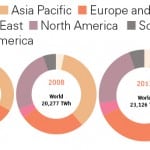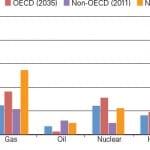The revolution that has toppled coal from the top of the generating queue in the U.S. has not reached the rest of the world, according to the “BP Statistical Review of World Energy.”
While natural gas may have supplanted coal as king of the hill in the U.S. electric generating mix, the solid mineral—geographically the most widely distributed fuel in the world—was the fastest-growing energy resource in the world, according to the BP analysis. Nuclear showed the sharpest decline during 2012.
The nuclear woes are not a surprise, given the continuing political and economic fallout from the 2011 catastrophe at Japan’s Fukushima nuclear station. Nuclear generation in 2012 saw the largest decline among generating technologies. Nor is there any reason for optimism for nuclear in the world’s most advanced economies, although that’s not true for the developing world, particularly China.
According to the BP annual review, “Coal remained the fastest-growing fuel, with China consuming half of the world’s coal for the first time—but it was also the fossil fuel that saw the weakest growth relative to its historical average.” The analysis added, “Global nuclear power output had the largest decline ever, with Japanese output falling by nearly 90% as the response to the tragedy at Fukushima continued to unfold. Fossil fuel imports rose to compensate.”
Bob Dudley, BP’s group chief executive, said, “The year 2012 saw a slowdown in the growth of energy consumption globally, partly as a result of the economic showdown but also because individuals and businesses have responded to high prices by becoming more efficient in their use of energy. At the same time, the review shows that the supply of energy is coming from an increasing diversity of sources as the world’s energy market continues to adopt, innovate and evolve.”
Putting a positive face on a year that saw worldwide declines in electric generation, Dudley said that “2012 highlighted the flexibility of the world’s energy market and the innovative approaches that consumers and producers take in response to change.” Reflecting a continued world-wide recession in the developed world, BP noted, “All of the net growth [in energy supply and demand] took place in emerging economies, with China and India alone accounting for nearly 90% of the net increase in energy consumption.”
In terms of supply of energy resources, BP said that “the most notable phenomenon remains the American shale revolution. In 2012, the U.S. recorded the largest oil and gas production increases in the world, and saw the largest gain in oil production in its history.” Globally, natural gas “grew at a below-average rate.” But gas “was the only fossil fuel to see consumption growth accelerate in 2012. Cheaper natural gas competed strongly with coal in North America, displacing it as a power feedstock.”
Renewables, including hydro, “also competed strongly against coal globally; renewables in power generation grew by 15%.”
Among the highlights of the BP report:
- World natural gas consumption was up 2.2%, below the historical average of 2.7%. Global gas production was up 1.9% and 4.7% in the U.S. Global gas trade growth was a weak 0.1%.
- Coal consumption was up 2.5% worldwide, compared to the 10-year average of 4.4%. Chinese growth in coal consumption was up 5.4%, below the Chinese average. OECD coal consumption fell by 4.2%, including an 11.9% decline in the U.S.
- Global nuclear output fell by 6.9%, “the largest decline on record for a second consecutive year,” with Japanese nuclear output down 89%. Nuclear output around the world accounted for 4.5% of global energy consumption, “the smallest share since 1984.”
- Global hydro output grew by “an above-average 4.3%, with China accounting for all of the net increase. Hydroelectric output reached 6.7% of global energy consumption, the highest share on record.”
- Global renewables other than hydro show “mixed results.” Biofuels saw the first decline (0.4%) since 2000, and a 4.3% decline in the U.S. Renewables used in power generation grew by 15.2% globally, “slower year-on-year growth for the first time since 2008 but still slightly above the historical average.” Wind (plus 18.1%) accounted for more than half of the growth of renewables, “with China (34.6%) accounting for the largest increment in wind generation.” Solar grew the fastest (58%) but from a much smaller base. Renewables accounted for 2.4% of global energy consumption and a record 4.7% of global power generation.
Looking at the details, China’s 6.1% growth in coal consumption was weaker than the 10-year average, but still topped the world list. OECD coal consumption dropped 4.2%, led by the U.S. (with a decline of 11.9%), despite increases in Europe and Japan. Coal at 30% of global primary energy production was the highest since 1979. Coal production worldwide grew by 2%, led by China (up 3.5%) and Indonesia (up 9%), and the U.S. trailing with a coal production decline of 7.5%
In natural gas, says BP’s analysis, consumption was above average in South and Central America, Africa, and North America. The U.S. racked up an increase at 4.1%, while China gas consumption increased 9.9%, and Japan 10.3% (driven in part by the need to replace nuclear). EU gas consumption fell by 2.3% and the former Soviet Union by 2.6%. Gas production grew worldwide by 1.9%, with the U.S. leading the pack a 4.7% volumetric increase.
Nuclear, the worldwide weak sister, saw declines in consumption of OECD countries of 9.3%, which account for a large portion of the world’s nuclear electric consumption. U.S. consumption of nuclear-generated electricity decline 13.6%, according to the BP analysis. Even France, the nuclear of nations, saw consumption of nuclear energy decline by 4%. The most positive result for the atom was the Russian Federation, which saw consumption increase by 2.7%.
—Kennedy Maize is MANAGING POWER’s executive editor










